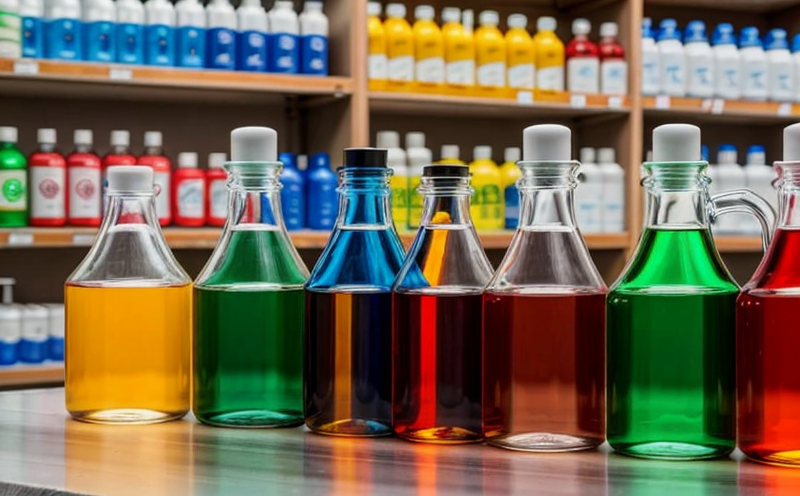GB T 17592 Determination of banned azo colorants in textiles
The GB/T 17592 standard is a crucial method used to determine the presence of restricted and banned azo colorants in textile products. These azo dyes can decompose under certain conditions, releasing potentially harmful aromatic amines into the environment or during consumer use. This test ensures that textiles meet stringent regulatory requirements for chemical safety.
The standard applies primarily to woven and knitted fabrics, as well as other types of textile materials intended for direct contact with skin. The method described in GB/T 17592 is based on the extraction of azo colorants using a mixture of water and sodium hydroxide solution followed by liquid-liquid extraction techniques. The extracted compounds are then analyzed using high-performance liquid chromatography (HPLC) or gas chromatography-mass spectrometry (GC-MS).
The test procedure involves several critical steps, including sample preparation, extraction solvent selection, pH adjustment, and the actual extraction process. Samples are typically cut into small pieces and homogenized before undergoing extraction in a mixture of water and sodium hydroxide at specific temperatures and durations. The extracted solution is then filtered and subjected to HPLC or GC-MS analysis for identification and quantification of azo colorants.
GB/T 17592 specifies the use of both qualitative and quantitative methods to identify and measure banned azo dyes in textile products. Qualitative tests can detect the presence of restricted substances, while quantitative tests provide precise concentration levels that are essential for compliance verification. This dual approach ensures comprehensive analysis and accurate reporting.
The standard also includes acceptance criteria for pass/fail results based on predefined limits set by regulatory authorities. Compliance with these limits is critical to ensure product safety and prevent potential health risks associated with the release of harmful aromatic amines.
For quality managers, compliance officers, R&D engineers, and procurement professionals involved in textile production and supply chain management, GB/T 17592 provides a robust framework for ensuring that textiles meet international standards for chemical safety. By adhering to this method, organizations can demonstrate their commitment to sustainable manufacturing practices and protect consumer health.
Industry Applications
The application of GB/T 17592 extends beyond mere compliance with regulations; it plays a vital role in enhancing the quality and safety of textile products across various sectors. The testing method is particularly relevant for manufacturers of clothing, footwear, and home textiles who must ensure that their products do not contain harmful azo colorants.
In the fashion industry, where trends change rapidly, ensuring product compliance with GB/T 17592 helps maintain a positive brand image and customer trust. Retailers and brands can use the test results to make informed decisions about sourcing materials from compliant suppliers, thereby reducing reputational risks associated with non-compliance.
For manufacturers of medical garments and personal protective equipment (PPE), compliance with this standard is not just optional but mandatory due to strict health and safety requirements. The presence of azo colorants in these products could pose significant risks if the dyes release harmful aromatic amines during use or through washing processes.
In home textiles like bedding, towels, and curtains, where prolonged contact with skin is common, ensuring that fabrics do not contain restricted azo colorants is essential for maintaining consumer safety. The test results can be used to justify claims of chemical safety made on product labels, providing consumers with the confidence they need when purchasing these items.
Why Choose This Test
Selecting GB/T 17592 as your testing method offers several key advantages that align with modern manufacturing and quality control practices:
- Comprehensive Analysis: The method provides a thorough examination of textile products, ensuring the detection of even trace amounts of restricted azo colorants.
- Regulatory Compliance: By adhering to this standard, manufacturers can confidently meet local and international regulatory requirements for chemical safety in textiles.
- Risk Mitigation: Identifying and eliminating banned substances helps reduce the risk of product recalls and legal disputes related to non-compliance.
- Consumer Trust: Demonstrating adherence to rigorous testing protocols enhances brand reputation and builds trust with consumers.
- Sustainable Manufacturing: Ensuring compliance supports environmentally responsible practices by reducing waste associated with non-compliant products.
The use of GB/T 17592 also facilitates the development of safer, more sustainable textile products that meet growing consumer demand for eco-friendly and high-quality materials. By incorporating this test into your quality control processes, you can stay ahead of industry trends and maintain a competitive edge in the global marketplace.
Use Cases and Application Examples
The GB/T 17592 method is widely used in various contexts to ensure textile products meet stringent safety standards. Here are some specific use cases and application examples:
Fashion Industry: Major fashion brands often require suppliers to undergo regular testing for azo colorants as part of their supply chain management processes. This ensures that all garments, accessories, and footwear comply with international regulations.
Medical and Personal Care Products: Hospitals and healthcare providers use textiles in patient gowns, sheets, and other equipment where stringent chemical safety is required. Testing for banned azo colorants is a critical step in ensuring the safety of these products.
Home Textiles: Manufacturers of bedding, towels, and curtains frequently conduct GB/T 17592 tests to verify that their products are free from restricted substances, thus protecting consumers who come into prolonged contact with these items.
R&D and Innovation: Research and development teams use this method to explore new materials and dyes while ensuring compliance throughout the innovation process. This helps in identifying potential issues early on and making necessary adjustments before product launch.
Supply Chain Management: Procurement departments rely on GB/T 17592 results to assess supplier performance and maintain a high standard of quality across all sourced materials. Regular testing ensures that suppliers consistently meet the required safety standards.





